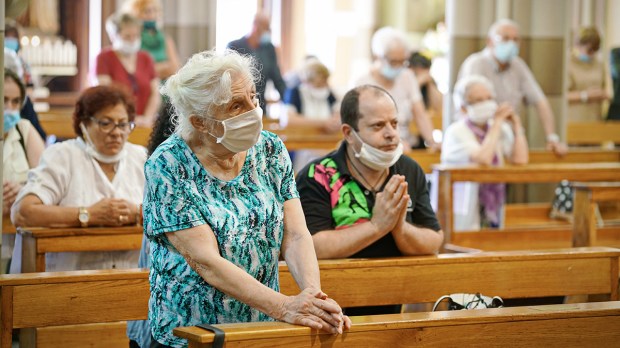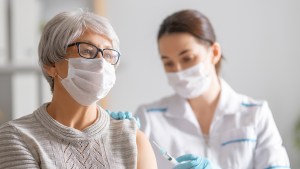As federal and state authorities begin to relax COVID-19 pandemic restrictions, churches around the country are inching back to normal practices for gathering.
For some Catholic dioceses in the United States, that began with announcements that the obligation to attend Mass on Sundays and holy days of obligation would no longer be suspended.
On May 13, the Catholic Conference of Ohio issued a joint statement saying that the general obligation to attend Mass on Sundays and Holy Days of Obligation (including the Saturday/Vigil Mass) is to be reinstated. “This will take effect in each of the Dioceses of Ohio the weekend of June 5-6, 2021,” said the statement, signed by bishops of the state’s six Latin dioceses. That Sunday, in the Ohio dioceses, is the Solemnity of the Most Holy Body and Blood of Christ, also known as Corpus Christi.
The statement came out the same day the U.S. Centers for Disease Control and Prevention (CDC) said that fully vaccinated people “can resume activities without wearing a mask or physically distancing, except where required by federal, state, local, tribal, or territorial laws, rules, and regulations, including local business and workplace guidance.”
Archbishop Dennis Schnurr of Cincinnati the next day said that, following the lifting of a statewide mask mandate on June 2, “there will be no mask mandate for churches of the Archdiocese of Cincinnati.”
In their joint statement, the bishops of Ohio said that those who have a serious reason are exempt from attending Mass on Sundays and Holy Days of Obligation, including those who are ill, have significant health risk factors or care for someone who is immuno-compromised or ill, as well as those who have significant fear or anxiety of contracting the coronavirus in a large group of persons. “Nevertheless, these persons should observe the Lord’s Day and are encouraged to spend time in prayer on Sunday, meditating on the Lord’s passion, death and resurrection.”
They said that viewing a broadcast of Mass on television or the internet is “an appropriate way to do this,” but that it is “not intended as a substitute” for those who are able to attend in person. The obligation to attend Mass exists, they continued, not because God needs to be worshipped; rather, it is “a gift to the faithful for their spiritual well-being, eternal salvation and formation in our relationship with God and one another.”
Around the nation
In the Diocese of Pittsburgh, Pennsylvania, Bishop David Zubik said that fully vaccinated churchgoers may now attend Masses and all gatherings on parish property without wearing a mask. However, in order to accommodate those who are not fully vaccinated, and those who may feel more comfortable seated around others who are wearing a mask, a section in every church will be maintained for mask wearing.
The Diocese of Charlotte, North Carolina, also followed the lead of the May 13 CDC announcement and a revision to state policy. Beginning on Pentecost Sunday, May 23, the obligation to attend Mass will be restored, except for those who remain vulnerable to the coronavirus.
Attendees are no longer required to social distance or use masks, the diocese said, but those who remain vulnerable are advised to continue wearing face coverings or “attend Mass virtually.” In addition, Masses and confessions are to return to their pre-COVID schedules beginning Pentecost Sunday, May 23.
The diocese will continue suspending the practice of receiving Communion from the chalice and shaking hands at the Sign of Peace, but the faithful may receive Communion on the tongue or in the hand.
On May 10, before the CDC released its revised guidelines, the Archdiocese of Hartford, Connecticut, said that though masks would still be required in church, churches “can reopen to 100% capacity with no need for any specific social distancing.” Pew barriers and tape, signs, etc. that were previously used to direct the flow of traffic in aisles can be removed.
Hymnals and missalettes can be returned to pews and used during Mass. Congregational singing is allowed again, but masks need to remain on during singing. “Choirs and musicians can be reintroduced as deemed appropriate by the pastor,” the guidelines said.
But churches are encouraged to “provide for the best possible ventilation by opening doors and windows when able.”
Health officials have said recently that, contrary to what was first believed, there is a low chance of catching the coronavirus from touching surfaces, but that the virus is spread mainly through the air.
The Archdiocese of Hartford also said in its new guidelines that people may gather before and after Mass, as they did before the pandemic. During Mass, however, the Sign of Peace should be exchanged only without contact, such as with a bow.
Also on May 13, the Archdiocese of Baltimore announced that parishes would be allowed to reduce social distancing in churches from 6 feet to 3 feet between congregants from different households.
Two days later, the archdiocese announced that because Gov. Larry Hogan had lifted the state’s indoor mask mandate, masks would no longer be required on parish grounds. However, it said that wearing masks is “still strongly encouraged for those who are not vaccinated.”
The dispensation from the Mass attendance obligation, issued at the onset of the pandemic, remains in place.
In Minnesota, the Archdiocese of St. Paul and Minneapolis advised pastors to take their city’s local mask-related ordinances into consideration before changing policies. Officials wrote to parishes a day after the CDC issued its new guidance and Minnesota Gov. Tim Walz announced a lifting of the statewide mask mandate
“It remains the prerogative of the pastor to determine an appropriate timeline for introducing changes, taking into consideration that time that the faithful may need to adjust to a change,” the message said. “Please note that the Governor’s latest Order does not change social distancing guidelines; consequently, we are still required to maintain six feet of social distance between households until May 28.”
In a May 16 statement, the Diocese of Santa Rosa, California, said that since Sonoma County moved into the safer “Orange Tier” in its COVID-19 monitoring system, churches can now allow for 50% capacity at all Masses.
“We all still need to be aware of the need to wear masks and to do our best to keep our distance from non-family members while in the pews,” the statement said.
The diocese’s cathedral parish said it had resumed Confessions being heard inside confessionals, which contain a sanitizing ultra-violet light.



